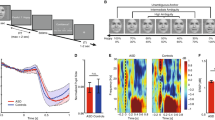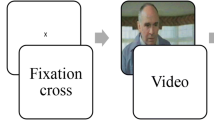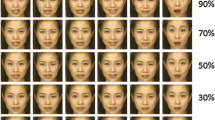Abstract
Typical adults use predictable scan patterns while observing faces. Some research suggests that people with autism spectrum disorders (ASD) instead attend to eyes less, and perhaps to the mouth more. The current experiment was designed as a direct measure of scan paths that people with and without ASD use when identifying simple and complex emotions. Participants saw photos of emotions and chose emotion labels. Scan paths were measured via infrared corneal reflectance. Both groups looked significantly longer at eyes than mouth, and neither overall looking time at eyes nor first fixations distinguished the groups. These results are contrary to suggestions that those with ASD attend preferentially to the mouth and avoid the eyes. Furthermore, there was no interaction between group and area of the face: the ratio of attention between eyes and mouth did not differ between the ASD and control groups. However, those with ASD looked at the eyes less than the control group when viewing complex emotions.









Similar content being viewed by others
References
American Psychiatric Association. (1994). Diagnostic and statistical manual of mental disorders (4th ed.). Washington, D.C.: American Psychiatric Publishing, Inc.
Baron-Cohen, S., Campbell, R., Karmiloff-Smith, A., Grant, J., & Walker, J. (1995). Are children with autism blind to the mentalistic significance of the eyes? British Journal of Developmental Psychology, 13, 379–398.
Baron-Cohen, S., & Cross, P. (1992). Reading the eyes: Evidence for the role of perception in the development of a theory of mind. Mind and Language, 6, 173–186.
Baron-Cohen, S., Wheelwright, S., & Jolliffe, T. (1997). Is there a “language of the eyes”? Evidence from normal adults, and adults with autism or Asperger Syndrome. Visual Cognition, 4, 311–331.
Barton, J. J. S., Keenan, J. P., & Bass, T. (2001). Discrimination of spatial relations and features in faces: Effects of inversion and viewing duration. British Journal of Psychology, 92, 527–549.
Boucher, J. D., & Ekman, P. (1975). Facial areas and emotional information. Journal of Communication, 25, 21–29.
Boucher, J., & Lewis, V. (1992). Unfamiliar face recognition in relatively able autistic children. Journal of Child Psychology and Psychiatry, 33, 843–859.
Braverman, M., Fein, D., Lucci, D., & Waterhouse, L. (1989). Affect comprehension in children with pervasive developmental disorders. Journal of Autism and Developmental Disorders, 17, 301–316.
Buitelaar, J. K., Van der Wees, M., Swabb-Barneveld, H., & Van der Gaag, R. J. (1999). Theory of mind and emotion-recognition functioning in autistic spectrum disorders and in psychiatric control and normal children. Development and Psychopathology, 11, 39–58.
Caldara, R., Schyns, P., Mayer, E., Smith, M. L., Gosselin, F., & Rossion, B. (2005). Does prosopagnosia take the eyes out of face representations? Evidence for a defect in representing diagnostic facial information following brain damage. Journal of Cognitive Neuroscience, 17, 1652–1666.
Celani, G., Battacchi, M. W., & Arcidiacono, L. (1999). The understanding of the emotional meaning of facial expressions in people with autism. Journal of Autism and Developmental Disorders, 29, 57–66.
Davies, G., Ellis, H., & Shepherd, J. (1977). Cue saliency in faces as assessed by the “photofit” technique. Perception, 6, 263–269.
de Gelder, B., Vroomen, J., & van der Heide, L. (1991). Face recognition and lip-reading in autism. European Journal of Cognitive Psychology, 3, 69–86.
Dunlap, K. (1927). The role of eye muscles and mouth muscles in the expression of the emotions. Child Behaviour, Differential and Genetic Psychology, 2, 199–233.
Ekman, P., & Friesen, W. V. (1971). Constants across cultures in the face and emotion. Journal of Personality and Social Psychology, 17, 129.
Faul, F., Erdfelder, E., Lang, A.-G., & Buchner, A. (2007). G*Power 3: A flexible statistical power analysis program for the social, behavioral, and biomedical sciences. Behavior Research Methods, 39, 175–191.
Fraser, I. H., Craig, G. L., & Parker, D. M. (1990). Reaction time measures of feature saliency in schematic faces. Perception, 19, 661–673.
Gepner, B., deGelder, B., & deSchonen, S. (1996). Face processing in autistics: Evidence for a generalised deficit? Child Neuropsychology, 2, 123–139.
Hadwin, J., Baron-Cohen, S., Howlin, P., & Hill, K. (1996). Can we teach children with autism to understand emotions, belief or pretence? Development and Psychopathology, 8, 345–365.
Haig, N. D. (1985). How faces differ – A new comparative technique. Perception, 14, 601–615.
Haig, N. D. (1986). Exploring recognition with interchanged facial features. Perception, 15, 235–247.
Hanawalt, N. G. (1944). The role of the upper and the lower parts of the face as the basis for judging facial expressions: II. In posed expressions and “candid camera” pictures. The Journal of General Psychology, 31, 23–36.
Happé, F., & Frith, U. (2006). The weak central coherence account: Detail-focussed cognitive style in autism spectrum disorders. Journal of Autism and Developmental Disorders, 36, 5–25.
Hobson, R. P. (1986). The autistic childs appraisal of expressions of emotion. Journal of Child Psychology and Psychiatry and Allied Disciplines, 27, 321–342.
Hobson, R. P., Ouston, J., & Lee, A. (1988). What’s in a face? The case of autism. British Journal of Psychology, 79, 441–453.
Howlin, P., Baron-Cohen, S., & Hadwin, J. (1999). Teaching children with autism to mind-read: A practical guide. Chichester: Wiley.
Joseph, R. M., & Tanaka, J. (2003). Holistic and part-based face recognition in children with autism. Journal of Child Psychology and Psychiatry, 44, 529–542.
Klin, A., Jones, W., Schultz, R., Volkmar, F., & Cohen, D. (2002). Visual fixation patterns during viewing of naturalistic social situations as predictors of social competence in individuals with autism. Archives of General Psychiatry, 59, 809–816.
Klin, A., Sparrow, S., de Bildt, A., Cicchetti, D., Cohen, D., & Volkmar, F. (1999). A normed study of face recognition in autism and related disorders. Journal of Autism and Developmental Disorders, 29, 499–508.
Langdell, T. (1978). Recognition of faces – Approach to study of autism. Journal of Child Psychology and Psychiatry and Allied Disciplines, 19, 255–268.
Lord, C., Risi, S., Lambrecht, L., Cook, E. H., Leventhal, B. L., DiLavore, P. C., et al. (2000). The Autism Diagnostic Observation Schedule–Generic: A standard measure of social and communication deficits associated with the spectrum of autism. Journal of Autism and Developmental Disorders, 30, 205–223.
Loveland, K. A., Tunali-Kotoski, B., Chen, Y. R., Ortegon, J., Pearson, D. A., Brelsford, K. A., et al. (1997). Emotion recognition in autism: Verbal and nonverbal information. Development and Psychopathology, 9, 579–593.
Nishimura, M., Rutherford, M. D., & Maurer, D. (2007). Evidence of configural face processing in adults with autism. Visual Cognition.
Ozonoff, S., Pennington, B. F., & Rogers, S. J. (1990). Are there emotion perception deficits in young autistic children? Journal of Child Psychology and Psychiatry and Allied Disciplines, 31, 343–361.
Pelphrey, K. A., Sasson, N. J., Reznick, J. S., Paul, G., Goldman, B. D., & Piven, J. (2002). Visual scanning of faces in autism. Journal of Autism and Developmental Disorders, 32, 249–261.
Plaisted, K., Saksida, L., Alcantara, J., & Weisblatt, E. (2003). Towards an understanding of the mechanisms of weak central coherence effects: Experiments in visual configural learning and auditory perception. Philosophical Transactions of the Royal Society of London Series B-Biological Sciences, 358, 375–386.
Rutherford, M. D., Clements, K., & Sekuler, A. B. (2007). Differences in discrimination of eye and mouth displacement in autism spectrum disorders. Vision Research, 47, 2099–2110.
Rutherford, M. D., & McIntosh, D. I. (2007). Rules versus prototype matching: Strategies of perception of emotional facial expressions in the autism spectrum. Journal of Autism and Developmental Disorders, 37, 187–196.
Schyns, P. G., Bonnar, L., & Gosselin, F. (2002). Show me the features! Understanding recognition from the use of visual information. Psychological Science, 13, 402–409.
Sergent, J. (1984). Configural processing of faces in the left and right cerebral hemispheres. Journal of Experimental Psychology: Human Perception and Performance, 10, 554–572.
Silver, M., & Oakes, P. (2001). Evaluation of a new computer intervention to teach people with autism or Asperger syndrome to recognize and predict emotions in others. Autism, 5, 299–316.
Spezio, M. L., Adolphs, R., Hurley, R. S. E., & Piven, J. (2007a). Abnormal use of facial information in high-functioning autism. Journal of Autism and Developmental Disorders, 37, 929–939.
Spezio, M. L., Adolphs, R., Hurley, R. S. E., & Piven, J. (2007b). Analysis of face gaze in autism with “Bubbles”. Neuropsychologia, 45, 144–151.
Sullivan, L. A., & Kirkpatrick, S. W. (1996). Facial interpretation and component consistency. Genetic, Social, and General Psychology Monographs, 122, 389–404.
Tanaka, J. W., & Farah, M. J. (1993). Parts and wholes in face recognition. Quarterly Journal of Experimental Psychology: A Human Experimental Psychology, 46a, 225–245.
Tantam, D., Monaghan, L., Nicholson, H., & Stirling, J. (1989). Autistic children’s ability to interpret faces: A research note. Journal of Child Psychology and Psychiatry and Allied Disciplines, 30, 623–630.
Teunisse, J. P., & de Gelder, B. (2001). Impaired categorical perception of facial expressions in high-functioning adolescents with autism. Child Neuropsychology, 7, 1–14.
Teunisse, J. P., & de Gelder, B. (2003). Face processing in adolescents with autistic disorder: The inversion and composite effects. Brain and Cognition, 52, 285–294.
van der Geest, J. N., Kemner, C., Verbaten, M. N., & van Engeland, H. (2002). Gaze behavior of children with pervasive developmental disorder toward human faces: A fixation time study. Journal of Child Psychology and Psychiatry, 43, 669–678.
Author information
Authors and Affiliations
Corresponding author
Additional information
This research was supported by a Social Sciences and Humanities Research Council grant to MDR.
Rights and permissions
About this article
Cite this article
Rutherford, M.D., Towns, A.M. Scan Path Differences and Similarities During Emotion Perception in those With and Without Autism Spectrum Disorders. J Autism Dev Disord 38, 1371–1381 (2008). https://doi.org/10.1007/s10803-007-0525-7
Received:
Accepted:
Published:
Issue Date:
DOI: https://doi.org/10.1007/s10803-007-0525-7




